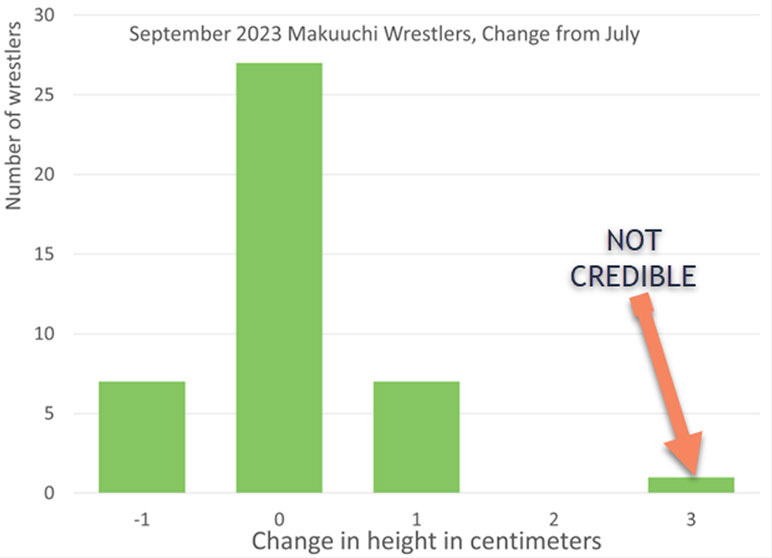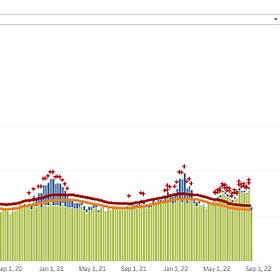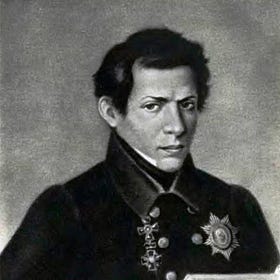The Week in Meep: The Return of Stu! Also: I Write Elsewhere
Stu (my husband, and the STU part of STUMP… yes, he doesn’t write, but he contributes in the background) has been in the hospital from Tuesday to today. He got a second blood transfusion, by the way. To make it clear: he just got home.
It relates to his cancer situation, which I explained a little in this post:
Here, have an extra picture from 2018 (it showed up in my Facebook memories today):
More recently:
I’m not going to get into the grody details (you don’t want to know), but the reason I haven’t been posting as frequently as I usually do is because of these issues. Stu’s cancer is a chronic situation, and sometimes it’s worse.
What’s nice is that I do write and contribute elsewhere (for free) that has a long(er) lead time, so hey, I’ve got some stuff I can link to!
Who (or What) To Trust? Going Back to Basic Principles
This was just published at The Stepping Stone, the newsletter of the Leadership & Development Section at the Society of Actuaries.
Who (or What) To Trust? Going Back to Basic Principles
When I was a kid, my mom used to drop me off at the local library on the weekend. I’d sit in the nonfiction section for a few hours, perusing the books. I especially loved camping out near the beginning of the Dewey Decimal system, because that’s where the “weird stuff” was.
….
I was a teenage Mulder,[2] and though I didn’t have the “I WANT TO BELIEVE” poster on my wall, I may as well have. I sucked in the stories of ESP, telekinesis, and more.
….
Ultimately, in combing through the nonfiction section of the local library, I also ran into two other books, not just the pro-ESP ones: Fads and Fallacies in the Name of Science, by Martin Gardner, and Flim-Flam! By James Randi. While Martin Gardner was best-known for writing on mathematical topics for Scientific American magazine, he also had a talent for amateur magic. James Randi was no amateur at magic. This is relevant to the matter at hand, as magicians are deception experts. In the research of ESP, there was deception galore, whether on purpose by researchers or research subjects.
Reading Randi’s and Gardner’s books, I learned of the many problems of “evidence” for all the paranormal phenomena I had wanted to believe in. The main problem was that it was easy to see how the results could be generated through non-ESP means. It was clear once a skeptical magician showed how research subjects could get information about the cards they were supposed to view via “second sight.” In other cases, it turned out that research data had been falsified to get the desired results.
Check out the article over there.
It includes this graphic:
Related posts:
A Tale of Know Your Data: The Mystery of the Excess Connecticut Summer Deaths
Before I begin, I’m going to give the game away:
Geeking Out: In Death Rates, the Denominator Is Also Important
About a month ago, I posted about cancer death rates by age and sex and noticed this:
’
Sunday Sumo: Actuarial Standards and Sumo Stats
Last week, I had the new sumo tournament top rankings height-weight graph updated… but it wasn’t quite right. The new rankings were updated, but the weigh-in hadn’t occurred yet.
Plagiarism and Faked Data in Academia
In which I discuss the recent brou-ha-ha over ex-President of Harvard Claudine Gay’s plagiarism in her published papers (and dissertation), the likelihood of widespread plagiarism (in certain fields), and the incentives to plagiarism and faked data in academia.
There are a few more… and I have further ideas for another podcast episode, but I given current conditions, I don’t know when I’ll be able to record & edit my next episode. So I’ll leave it here.
Papal (and curial) mortality
I didn’t write this one, but I contributed some data/analysis. This is from a few weeks back, but didn’t link to it yet.
Pillar Catholic: Is papal demography destiny?
This was written by Brendan Hodge, dated July 10, 2024.
Pope Francis, head of the Vatican City State — and the Catholic Church — is 87, six years older than the U.S. president, making him the fourth oldest head of state in the world, among governments recognized as states by the Holy See itself.
The three who are older are: President Biya of Cameroon, 91, President Mahmoud Abbas of the Palestinian Authority, 88 — the Holy See recognized Palestine as a state in 2015 — and King Salman al Saud of Saudi Arabia, 88.
The pope does not face the rigors of an election cycle, and popes normally serve until death.
Well, when will that be? Or, rather, could that be?
Anyway, I started with Pope Francis’s current age, looked at a couple of different mortality table sets for a range of curves, and projected as you see here. Then Brendan Hodge put it in Datawrapper (or the editorial folks did).
In any case, the short version is the 50/50 on the Pope is about 5 years. So now you know.










